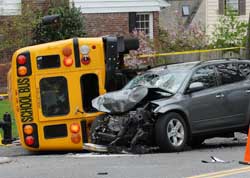Event Data Recorders
- Basic Description
-
 Event data recorders (EDRs), sometimes referred to as automotive "black boxes", are
systems that constantly record
information related to the vehicle operation. In the event of an accident, the recorder saves the
information that was recorded several seconds just before and/or just after the collision. EDRs may be independent electronic control units or they may reside within other control modules such as the engine control (ECM) or airbag control module. Event data recorders (EDRs), sometimes referred to as automotive "black boxes", are
systems that constantly record
information related to the vehicle operation. In the event of an accident, the recorder saves the
information that was recorded several seconds just before and/or just after the collision. EDRs may be independent electronic control units or they may reside within other control modules such as the engine control (ECM) or airbag control module.
Unlike Accident Recorders, which are after-market systems that usually record video and GPS location data, EDRs are installed by the vehicle manufacturer and integrated with existing systems and sensors. In the U.S., most passenger cars, multipurpose passenger vehicles, trucks, and buses manufactured after September 1, 2014 are required to have an EDR installed. Modern EDRs record various operational parameters such as vehicle speed, pedal
positions, steering wheel position and other information that may be relevant to a crash investigation. In the event of a crash, about 5 seconds of this data is stored in non-volatile memory.
Requirements for the type of data that must be recorded by EDRs in the U.S. are spelled out in the Code of Federal Regulation, 49 CFR Part 563, [2]. This regulation requires that EDRs record the following data:
- Change in forward crash speed
- Maximum change in forward crash speed
- Time from beginning of crash at which the maximum change in forward crash speed occurs
- Speed vehicle was traveling
- Percentage of engine throttle, percentage full (how far the accelerator pedal was pressed)
- Whether or not brake was applied and the antilock brakes were activated
- Ignition cycle (number of power cycles applied to the EDR) at the time of the crash
- Ignition cycle (number of power cycles applied to the EDR) when the EDR data is downloaded
- Whether or not driver was using a safety belt
- Whether or not frontal airbag warning lamp was on
- Driver frontal airbag deployment: time to deploy for a single stage airbag, or time to first stage deployment for a multistage airbag
- Right front passenger frontal airbag deployment: time to deploy for a single stage airbag, or time to first stage deployment for a multistage airbag
- Number of crash events
- Time between multiple crash events
- Whether or not EDR completed recording
The regulation also specifies additional parameters that must be recorded under certain minimal conditions, including:
- Change in lateral vehicle speed
- Maximum change in lateral speed
- Time from beginning of crash at which the maximum change in lateral crash speed occurs
- Engine RPM
- Steering wheel angle
- Vehicle roll angle, in case of a rollover
- Antilock braking system status
- Electronic stability control status
- Safety belt status
- Front air bag suppression switch status
- Front air bag deployment status
- Side air bag deployment status
- Pretensioner deployment
- Front seat positions
- Front passenger occupant size
- Front passenger occupant position
The regulation also requires that automakers ensure that there is a commercially available tool for downloading the EDR data.
EDRs are not required in Europe, but a recent study concluded that "all (or almost all)" new passenger cars sold in Europe have EDRs that record information comparable to the U.S. requirement [5].
- Sensors
- Vehicle speed, engine rpm, steering wheel angle, angular rate sensor, accelerator pedal position, throttle position, brake pedal switch, seat position, occupant weight and position
- Actuators
- Data stored in non-volatile memory
- Data Communications
- CAN or OBDII
- Manufacturers
- Bosch, Continental, Delphi
- For More Information
- [1] Event Data Recorder, Wikipedia.
- [2] 49 CFR 563 - Event Data Recorders, U.S. Government Publishing Office, Oct. 1, 2011.
- [3] Yes, Your New Car Has A 'Black Box.' Where's The Off Switch?, NPR All Things Considered, Mar. 20, 2013.
- [4] Q&A: Event Data Recorders, Insurance Institute for Highway Safety website, Mar. 2014.
- [5] Study on the Benefits Resulting from the Installation of Event Data Recorders, D. Hynd and M. McCarthy, TRL PPR707, 2014.
|

